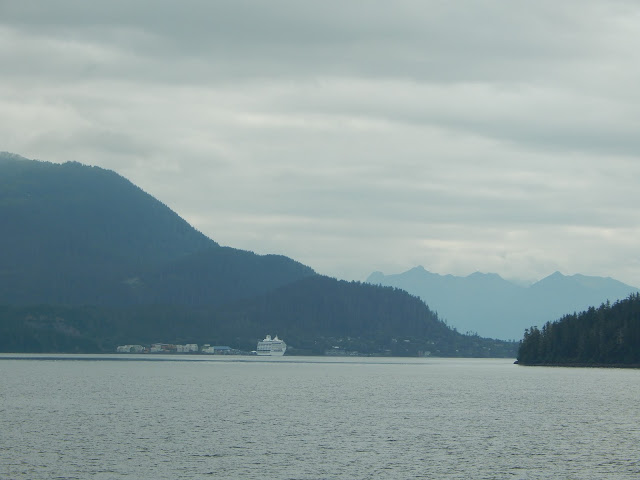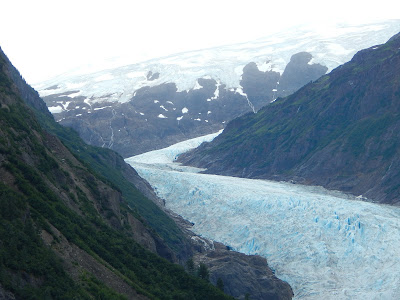Our trip home on the Alaska ferry started in Skagway; Alaska, which punctuates the top of the picturesque north-south Lynne Canal. Standing on the deck of the MV Leconte (one of the original Alaska ferries), mountains towered over us to both the east and west sides. As we moved away from land on our way south through the Inside Passage, even the four cruise ships we left behind were dwarfed by the setting.
 |
| The Leconte is overshadowed by the cruise ship and the mountains. Notice Harding Glacier at the upper left. |
I was excited to be moving out onto the water. I left Lynne in the comfortable observation lounge and ventured out on the deck. The wind picked up my hair and billowed my jacket. As the land receded, the sky revealed itself, filling the space above and beyond the islands and mountains. In the coming days, from the ferry, I saw endless vistas of mountains receding into clouds, shorelines overlaid with early morning fog, and trees blurred through mist, the atmospheric conditions softening the steady, slow passage south. In that way, all four legs of our trip on the
 |
| The back deck of the MV Fairweather |
Lynne and I took three different Alaska ferries, embarking first from Skagway , stopping for a couple of days in Haines, one night in Juneau and two nights in Sitka . I loved watching the coast diminish quickly each time we pulled away from the dock.
I felt safe and also connected with my ship community, the passengers and the crew. Occasionally, the ferry sailed past cruise
ships or fishing boats, but mostly, we were alone on the rolling water. I got
used to the feeling of the deck moving slightly under my feet. I had to pay
attention as I walked the halls. I held onto the railings as I went up
the stairs.
Travelling on the ferry through southeast Alaska gave me a visual context for how sparsely populated this part of the world is, how much of the land is uninhabited or uninhabitable. Mountains and water separate the human holdings. Each town operates in its own sphere, claims its own part of the shoreline, apart from its nearest neighbors. “Near” is a relative word when the towns are separated by icefields or steep impassable mountains rising sharply from the sea. What ties these southeast Alaska communities together is the water, the water which provides vital transportation and livelihood to the residents.
 |
| A view of Haines, Alaska as we head south on the ferry |
Each of the three ferries (the
Leconte, Fairweather and the Matanuska, all named after glaciers) had
comfortable indoor observation lounges with ample windows for those absorbed in
the passing beauty. I brought a book to read, but hardly got a page read.
I saw some people doing jigsaw puzzles, or knitting, but most were gazing out
the windows or just leaning on the railing and scanning for wildlife. With no
Wi-Fi on the ship, people passed much of the time talking to each other.
Lynne and I had fun meeting
new people, like Donna and her husband Joe from Georgia Oregon Juneau Juneau Mt. Adams
At night, I experienced sleeping on the boat, the bed gently rocking. I had the feeling of
motion and simultaneously the feeling of deep relaxation that came with
leaving the navigation and driving to the crew, covering distance in the dark
as we slept. In the middle of one night, extra turbulence in the
water awakened me, swaying me back and forward in my bed, but I soon fell back to sleep.
At breakfast, the purser
made a quick announcement over the loudspeaker, alerting us to look out the
window. Standing up to see better out the wrap-around dining room
windows, we watched about eight humpback whales fishing near the ship, their
breath spewing up water, their fins slicing through the surface, their broad
dark flukes (tails) flipping up as they dove. Before our food could get cold,
they were gone.
The food was fun. The ship’s
white jacketed cooks offered up their food cheerfully. The kitchen was open most of the day.
It was a classic cafeteria line with trays that you slid down stainless steel
rails, the heat rising from steam tables with oatmeal, soup or chili. Specials were listed on a white board for every meal. After ten days of eating
our own (very healthy, well planned) cooking while we were camping, both Lynne
and I indulged in the kitchen's cooking. The last morning, I
had enough huevos rancheros to feed a ranch hand, and I enjoyed every bite.
Throughout our trip in Alaska Southeast Alaska is in a rainforest, so we had expected
the foggy weather, the showers, the cool air. We had prepared for this
weather and actually welcomed it after some hot days driving through southern BC. We heard occasional reports that the rest of the country was having a heat wave.
The large boat that we were
on for 36 hours was the MV Matanuska. It moves at approximately 19 mph (16.5
knots), day and night, carrying about 200 passengers and their RVs, cars, motorcycles, kayaks and bicycles. We traveled on it for 36 hours, from Sitka
to Juneau , Juneau
to Petersburg , then on to Wrangell, Ketchikan
and finally our destination, Prince
Rupert Juneau to Sitka
 |
| One lane of RVs being loaded on the ferry in Skagway. Notice the smallest RV. That's ours! Lynne and Winnie are standing in front. Two cruise ships block the mountains behind the scene. |
Tracing our route on the map, the ship went south from
Juneau on the Chatham Strait, then east, slowing down to negotiate the Peril
Strait and ending up south again on the Neva Strait to Sitka. You could skip
all this cruising and instead get there in 40 minutes by plane. Instead, we returned to Juneau on the Matanuska. Our ultimate
destination was Prince Rupert , 318 miles from Juneau
 |
| Approaching Juneau on the ferry, with a view of the Mendenhall Glacier. |
I am an insider of the Alaska ferry system, because my job is to provide
shoreside support to the ships which dock in Bellingham Alaska Alaska Sitka or Kodiak
or Anchorage Seattle
In the process of helping
passengers, I have gotten to know some of the crew, from the watchman to the stewards to the pursers to the
captains and the able bodied seamen and seawomen. It was fun to see them again in Alaska, and to meet more people who work on the ferry.
When I was first hired, in
2010, an immediate bonus was that my training included a trip up to Ketchikan Ketchikan
I am no longer new to the Alaska ferry system, yet the experience of being on the ferry as a
passenger during our recent trip was still an memorable adventure.
I came across these words
from “The Blue Boat Home” by Peter Mayer this week, and they express how I felt
about our sea journey:
I give thanks to the waves upholding me,
hail the great winds urging me on
Greet the infinite sea
before me
Sing the sky my sailor's song
Sing the sky my sailor's song












